M. Isidora Forrest's Blog, page 6
December 29, 2024
Isis & My ‘Epagomenal’ Days
This year, the holidays have not touched me.

Not Thanksgiving. Not Yule. Not any of the beautiful winter holidays of Light. I am just not feeling festive. I am too deeply concerned about my own country and much of the world. I am too deeply concerned about my community and many of the individual friends and loved ones who are a part of it.
Yet today, out of nowhere—while on a simple errand—I finally felt something. I felt the epagomenal days. I sensed myself existing in a time-out-of-time, in a strange unreality. Sound seemed dampened as a soft quietness fell over everything.
And I realized that my own feeling of unfestive unease may mirror the feelings that many ancient Egyptians would have had during their own epagomenal days.
 The Great Mother Nuet; artwork from the Damanhur Community, Italy
The Great Mother Nuet; artwork from the Damanhur Community, ItalyFor them, the epagomenal days were the five days before the summer rising of the Star of Isis, Sopdet (Sothis in Greek, Sirius in Latin). With the rising of Her Star, the New Year began.
(The Egyptian year had 360 days, but the solar year has 365.25. So the Egyptians made up the difference by adding five epagomenal—intercalary or “inserted into the calendar”—days at the end of the year.)
These days were also considered the birthdays of Osiris, Haroeris (Horus the Elder), Set, Isis, and Nephthys. So, you would think these would have been positive days for the Egyptians. But without the protection of the confines of the calendar, the Egyptian epagomenal days were thought to be a quite dangerous time. People wore special amulets and priests might perform the ritual of Sehotep Sakhmet, or “Pacifying/Satisfying Sakhmet,” because the demonic, disease-bringing hoards of the fierce Goddess were particularly rampant at the end of the year. (See more about epagomenal amulets here.)
 The beautiful Star of Isis, Sirius (Sopdet in Egyptian, Sothis in Greek) is directly overhead at the New Year
The beautiful Star of Isis, Sirius (Sopdet in Egyptian, Sothis in Greek) is directly overhead at the New YearOur December is most definitely not the time of the ancient Egyptian end-of-the-year epagomenal days. However, from winter solstice to the New Year is the time I consider to be my epagomenal days, for they are the end-of-year days in our modern calendar. And they, too, are the lead-in to a little miracle that involves the Star of Isis. More on that below.
So let’s talk a bit about the epagomenal days, including some ways to celebrate our own end of the year with Isis.
Epagomenal days as birthdays of the Deities
As early as the Middle Kingdom (2050-1650 BCE), these five extra days were associated with the Divine birthdays. Birthday festivals for each of these Deities were duly celebrated during each epagomenal day. The time between the winter solstice and our New Year is longer than the Egyptian period, but if you’d like to celebrate the birthdays of the Deities, one every other day rather than one per day would work out fairly well.
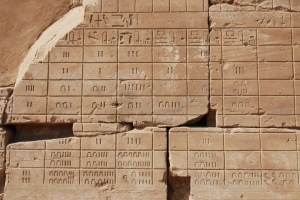 An ancient Egyptian calendar from the temple of Karnak
An ancient Egyptian calendar from the temple of KarnakOn the other hand, if you wish to be more Isis-centric in your worship, you could consider the entire period as holy days of the Goddess as the miracle of Her star approaches.
We can look to some ancient calendrical inscriptions for the day of Isis’ birthday to give us clues about options for honoring Her at this time. In a papyrus known as Leyden I, She is called “The Great One, Daughter of Nuet.” She is said to be “in Khemmis,” that is, in a particular city in the delta, and She is invoked particularly for protection.
In another papyrus, Leyden II, the fourth day is said to be named “the Pure One Who is in His Field.” The masculine pronoun would seem to exclude Isis. It could allude to Osiris—or it could be a scribal error. If it should have been the Pure One Who is in Her Field, it would make a good deal of sense in connection with Isis since She was closely associated with the pure new plants that would soon be coming forth from the Egyptian fields in the New Year.
In 1943, a papyrus was purchased by the Cairo museum from an antiquities dealer. It turned out to be three ‘books’ about the Egyptian calendar. Two were extremely damaged and hard to read. The third has become known as the Cairo Calendar and includes information on which days of the year were considered auspicious and which were not. Of course, it includes the epagomenal days. In it, the fourth epagomenal day, Isis’ birthday, is said to be named “He Who Makes Terror.” It includes a formula to be recited on that day:
“O, this Isis, Daughter of Nuet, the Eldest, Mistress of Magic, Provider of the Book, Mistress Who Appeases the Two Lords, Her Face is Glorious. I am the brother and the sister. The name of this day is He Who Makes Terror.”
Another calendar notes that the fourth day is called, “the Child Who is in His Nest; the Birth of Isis.” And you’ll remember from several weeks ago that at Denderah, the child in His nest is Re, Whose rising, after the rising of Isis’ star, marks the first day of the New Year. In fact, the Denderah temples include numerous references to Isis’ connection with the New Year and the important renewal it brings. There is some evidence that Isis’ temple at Philae may have been dedicated to Her on the 4th epagomenal day as a birthday present. We also have evidence of a lamp festival for Isis on Her birthday, which you can read about here.
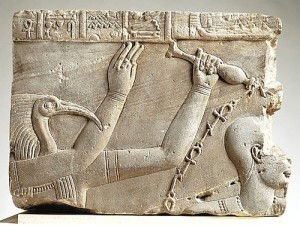 Thoth purifying the pharaoh from Isis’ temple at Philae
Thoth purifying the pharaoh from Isis’ temple at PhilaeDespite its preceding dangers, the ancient Egyptian New Year itself was a time of joy, rebirth, and renewal. Our own New Year can be the same for us. The ancient Egyptian themes are, after all, entirely in harmony with our modern New Year celebrations.
Like they did, we begin again.
We start over. We rededicate ourselves. We make resolutions to do things better. Purification is often associated with such reboots and so the epagomenal days would be a perfect time for purification prior to entering into the New Year. People participating in “Dry January” are undertaking a purification from alcohol. Lots of people start New Year’s diets then, too. We might also purify ourselves by bathing, fasting, purchasing new clothing, or purifying our sacred spaces by cleaning and straightening up our shrines—all the while invoking Isis to surround us with Her mighty wings, encircling us with Her protection.
Epagomenal days as the time of the Star of Isis

During our winter epagomenal days, we don’t witness the heliacal rising of the Star of Isis as the ancient Egyptians did. However, there is something very special that happens at this time of year for those of us in the northern hemisphere: Sirius reaches its zenith, its highest point in the night sky.
The beautiful, glittering star of Isis ascends high into the starry belly of Her mother Nuet at the stroke of midnight on January 1st—and She can be seen shimmering in that position for about the first week of January. And this year, there’s a bonus: we’ll also see Jupiter and Mars nearby and shining extra brilliantly as well.
So, just as the heliacal rising of Sirius heralded the ancient Egyptian New Year, the beautiful Star of Isis reaching its highest point in the sky can serve as a marker for our own modern New Year’s celebrations. You’ll find a small rite for celebrating here.
For me, here in Portland, it is likely that our cloudy skies will obscure the brilliance of the celestial show above, as they so often do. Nevertheless, I will be purifying myself, asking Isis for protection and growth, and using the small ritual at the link above to welcome in the renewal of the New Year.
Do you have anything special you’ll be doing?
December 22, 2024
More Epithets of Isis
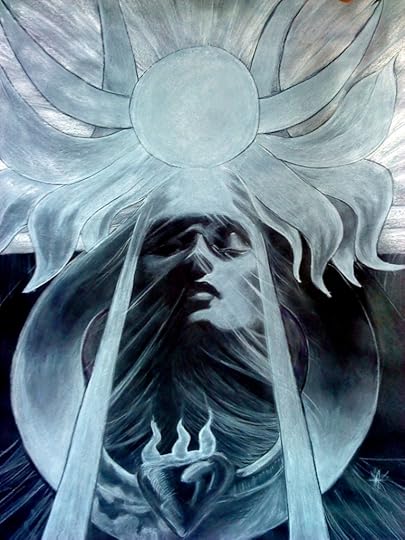 Parsifal by Jean Delville, but it definitely gives ‘mysteries’
Parsifal by Jean Delville, but it definitely gives ‘mysteries’Most of you reading this blog are well aware of the many epithets of Isis, Our Lady of 10,000 Names. In general, epithets are descriptions attached to the Goddess’ name that help us know more about Her. Very often, you’ll see people note that epithets are especially important in Deity invocations because they help us tune into the specific aspect of Their natures that we wish to connect with.
And that’s true.
Yet, I like to think of epithets as little Mysteries.
Each epithet of the Goddess has the possibility of revealing to us a Mystery—something about Isis we might not have known, or might not have known as deeply. In a post a couple weeks ago, one of the things we learned from the ancient Greek novel Aitheopika was that initiates of Her Mysteries called Isis the Earth and Osiris the Nile. I would not be at all surprised to learn that the revealing of additional epithets of the Goddess was a regular part of Her—and other Deities’—Mysteries. A Mystery initiation gave you insider knowledge about the Mystery Deity. Discovering new aspects of the Goddess through additional names and epithets would be some pretty solid insider information.

You’ll find epithets of Isis scattered throughout this blog. For instance, here are names and epithets honoring Isis from . Here are some of . There are about two hundred of Isis’ epithets listed in the appendix in Isis Magic. And Offering to Isis includes several epithets appropriate to each of the offerings—sacred symbols of the Goddess—as part of the invocation offerings.
Today, I’d like to share a few more epithets of Isis, some of which may be new to you. If you’d like to delve into the little Mysteries of these epithets for yourself, try this: Pick out a few that call to you. Open your shrine or temple in whatever manner you usually do. Invoke Isis using the epithet you chose. You can sing or chant the epithet as you call out to Her. When you sense Her presence, ask Her to reveal to you some of the Mysteries of that epithet. Then open your heart, open yourself, as you experience/intuit what She communicates to you. (Even better, jot down the things that come to your mind about that epithet for later reference. Visionary work sometimes fades rather quickly.)
In no particular order, here are some epithets of our Goddess from various parts of Egypt:
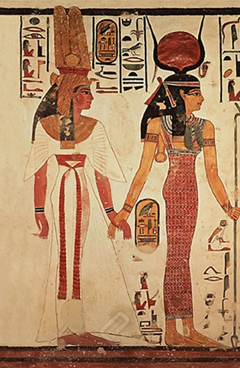 Isis in red, leading Nefertari
Isis in red, leading NefertariIsis, She Who Loves the Red Cloth; Iset Meret Ines—this epithet of Isis is found at Dendara. Interestingly enough, in representations of Isis, red is the most common color of Her clothing. The famous Knot of Isis is also usually made of red stone or painted red—and it may be meant to represent a knot tied in cloth. The ancient Egyptians associated red with fire, blood, and the sun. It could be a color of destructive power and associated with anger as well. We are used to Sakhmet being associated with red, but it turns out Isis is a Red Goddess, too.
Isis the Great Golden One; Iset Nebut Weret—while we are familiar with Isis being called, like Hathor, the Golden One, here She is the Great Golden One, an epithet She shares only with the Creator Goddess Neith. Gold is associated with the sun and Divinity. What does it mean that She is not only the Golden One, but the Great Golden One?
Isis, She of the Beautiful/Good/Perfect Face in the Barque of Eternity; Iset Noferet Hor em Wia Heh—the Barque of Eternity if the boat that travels into the Otherworld, both the underworld and the heavens. What does it mean that Isis is the beautiful-good-perfect face in that holy boat?
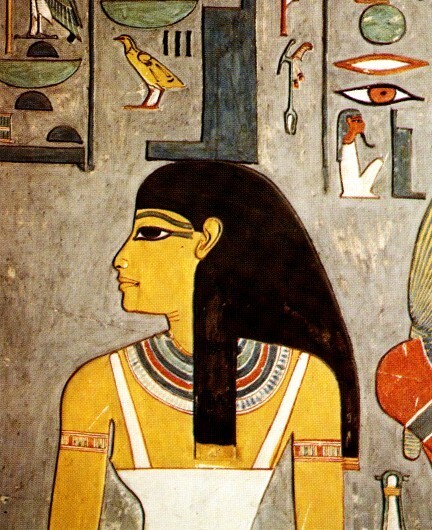 Isis with golden yellow skin
Isis with golden yellow skinIsis the Lady of Awfulness; Iset Nebet Neru—this is the literal meaning of awful, as in “full of awe,” but also a designation of Her great, and sometimes scary, power. See more about this one here.
Isis the Great One in the Beginning; Iset Weret em Hat—this epithet is from Her temple at Philae and is another epithet Isis shares only with the Creator Goddess Neith. This is Isis as a Primeval Goddess, the First Goddess. Similarly, She is called the Great Goddess “of the coming into being” and is the Great Goddess “in the First Time,” the Zep Tepi. We also have inscriptions calling Isis Sha’et, “She Who Was First,” from a number of places, including Philae, Dendara, and Edfu.
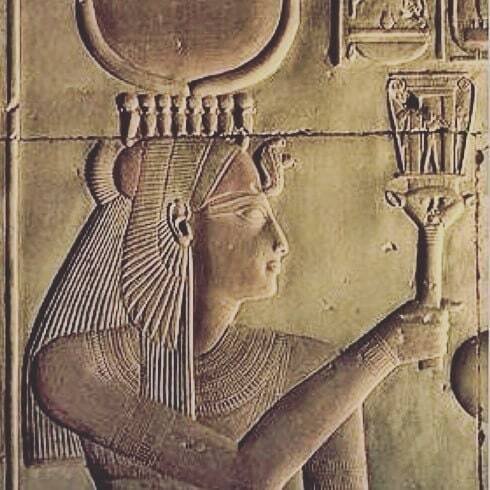 The Perfect Musician
The Perfect MusicianIsis the Great in the Place of Her Heart; Iset Weret em Set Ib-Es—this one is from the Horus temple at Edfu. What do you think ‘the place of Her heart’ is?
Isis, Her Years are Eternity and Everlastingness; Iset, Renput-s Neheh Djet—learn more about Neheh and Djet here and here.
Isis the Perfect Musician; Iset Khunet Noferet—from Dendara. Isis is also called “the Musician of the Spoken Words” and the Shemayet, the “Chantress.” The Chantress was a high-ranking priestess in ancient Egypt. Read more about AE priestesses and the Chantress here.
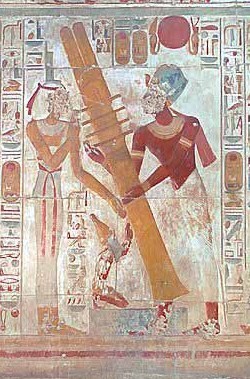 Isis and the pharaoh raising the djed pillar
Isis and the pharaoh raising the djed pillarIsis, She Who Makes Shadow with Her Feathers; Iset Iret Shut em Shuut-Es—from a stele now in the Louvre. We know about Her wing symbolism, but what about the shadow of Her wings?
Isis the Djed Pillar; Iset Djedet—now isn’t this interesting? Osiris is usually associated with the djed pillar. But here we have Isis as the female djed pillar. The djed represents stability, so that is likely the meaning here: Isis is strong, stable, dependable.
On the other hand, She also personifies Her own symbol, and is called Isis the Excellent Isis Knot (Iset Tiet Menkhet)…for Isis is All Things and All Things are Isis.
There are so many more, but that’s enough for now.
If, in your connections with Isis, you discover any of the Mysteries of these epithets, I hope you’ll share them here, on Facebook, or on BlueSky.
December 16, 2024
I’m on BlueSky now
December 15, 2024
Is Isis a Virgin Goddess?
 Seen this about a million times? Yeah, me, too.
Seen this about a million times? Yeah, me, too.It’s that time of year when we (once again) see all those articles comparing the Divine Mother Mary with the Divine Mother Isis, followed by either outrage or approbation, depending on who’s doing the writing.
Not long ago, in relation to this, a friend of this blog asked a very excellent question. It had to do with Isis’ status as a Virgin Goddess. Basically, is She or isn’t She? She is often compared with the famously Virgin Mary, and the images of the two Goddesses, nursing Their holy babes, are strikingly similar. And then there’s all of this.
Well, as is often the way with Goddesses, the answer is both no and yes.
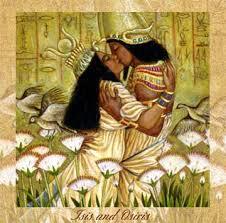
We’re all pretty familiar with the sexual relations between Isis and Osiris. All the way back to the Pyramid Texts we hear about it, rather explicitly we might add. Pyramid Text 366 says, “Your [Osiris] sister Isis comes to You rejoicing for love of You. You have placed Her on your phallus and Your seed issues into Her…” Plutarch, in the version of the story he recorded, tells us that Isis and Osiris were so in love with each other that They even made love while still within the womb of Their Great Mother Nuet. And, of course, we have the sacred story of how Isis collected the pieces of the body of murdered-and-dismembered Osiris, all except the phallus. Crafting a replacement of gold, the flesh of the Gods, She was able to arouse Her Beloved sufficient for the conception of Horus. The mourning songs of Isis and Nephthys have Her longing for His love. The priestess, in the Goddessform of Isis, sings that “fire is in Me for love of Thee” and She calls Him Lord of Love and Lord of Passion. She pleads, “Lie Thou with Thy sister Isis, remove Thou the pain that is in Her body.” (For more on the Songs or Lamentations, go here.)
So, is that all there is to it? Isis is not a virgin?
Well, not quite. Because Isis is a Goddess.

Isis is the Goddess of 10,000 Names and 10,000 Forms. Among those forms are the sexual Lover of Osiris and the Mother of Horus. Also among Her many Names are syncretisms with famously virginal Goddesses such as Artemis, Hekate, and Athena, as well as heroines such as Io, a virgin priestess of Hera (a Goddess Who Herself renews Her virginity on the regular). Isis is identified with both Demeter the Mother and Persephone the Kore, the Young Girl, Who were sometimes seen as a single unit, Mother-Daughter, containing All in Themselves. Goddesses can be many things, all at once, without any contradiction—or perhaps with every contradiction, which is one of the ways of Goddesses.
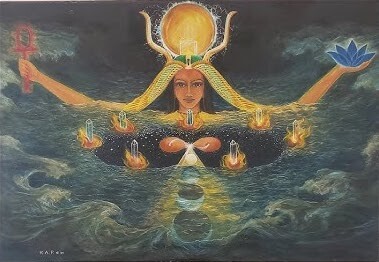
No text shows us these Divine Feminine contradictions/not-contradictions as clearly as “The Thunder, Perfect Mind,” a text found among the Nag Hammadi papyri. It is a long poem in the voice of a Feminine Divine Power that some scholars have linked to Isis; or at least they think that Her worship influenced the content of the text. Could be, but in my opinion, the Divine Speaker may be better understood as Sophia—with Whom Isis is also identified. The Coptic (late Egyptian) manuscript from which the text comes is dated to roughly 350 CE. Here’s a brief excerpt from this amazing work:
For I am the first and the last. I am the honored one and the scorned one. I am the whore and the holy one. I am the wife and the virgin. I am the mother and the daughter. I am the members of my mother. I am the barren one and many are her sons. I am she whose wedding is great, and I have not taken a husband.
The Thunder, Perfect Mind
Clearly, Isis is syncretized with Virgin Goddesses throughout the Mediterranean world. And it is not at all unusual for such Goddesses to be both virginal and associated with fertility. What about Egyptian sources?
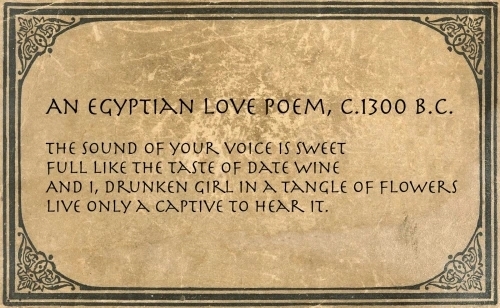
The ancient Egyptians were not quite so concerned with virgins—by which I mean, in this case, a young person who has not yet had sex—as were the Greeks and some other Mediterranean peoples. For instance, there was no requirement that young women or young men be sexually inexperienced when they married. Many young women probably were—particularly those who were married very young to older husbands. But prior to marriage, young people might engage relatively freely with each other. After marriage, sexual exclusivity was demanded—especially for women. The penalties for non-compliance could be very harsh—especially for women.
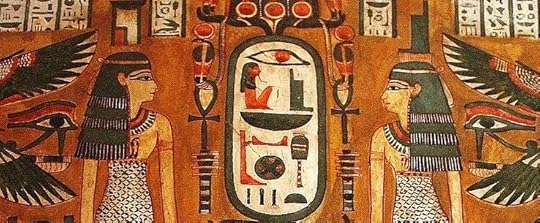 The Two Sisters
The Two SistersThis is not to say that Egyptian virginity was not valued or even required under certain circumstances. The text that included the lamentation songs of Isis and Nephthys noted above specifies that the priestesses taking the roles of Isis and Nephthys be “pure of body and virgin” and also that they are to have their body hair removed, wigs on their heads, tambourines in their hands, and the names of Isis and Nephthys inscribed on their arms.
This text, one of very few we have, is from the Ptolemaic period, when Egypt had been influenced by Greek rule. I wonder whether virginity would have been considered necessary earlier. Perhaps the priestesses would have only had to abstain from sex for a period of time before their ritual service. We know that people serving in Egyptian temples had to abstain from sex for a time (at least a day, often a number of days) as part of their purification. But they weren’t virgins.
 Ankhnesneferibre, God’s Wife of Amun
Ankhnesneferibre, God’s Wife of AmunThe God’s Wife of Amun, the highest of high priestesses, usually a female relation of the king, was virgin for life. Beginning in the 2nd Intermediate Period, the lifetime position of the God’s Wife gained a great deal of power, eventually becoming second only to the king. Interestingly, it was an “Isis”—Iset, the virgin daughter of Rameses VI—who began the tradition of the God’s Wife being celibate. Later, in the Roman period, some Roman priestesses of Isis maintained lifelong virginity. And we know that the Roman Isiacs might maintain a 10-day period of pre-ritual chastity known as the Castimonium Isidis or Chastity of Isis.
Isis Herself is called the Great Virgin in one of the inscriptions from the Isis Chapel in Seti I’s mortuary temple at Abydos. In Egyptian, this is Hunet Weret. Hunet is the word for girl or maiden, weret is the feminine form of great. Hunet is also the Egyptian name for the pupil of the eye and is connected to the Hermetic treatise known as the Kore Kosmou, the “Virgin of the World.” You can read about those maidenly connections here. (And read about the Kore Kosmou here, here, and here. )Just like Greek parthenos, hunet could mean a virgin, a girl, a maiden, or just youthful. (A young boy or youth is hunu.) And all Egyptian Goddesses are forever young.

Parthenogenesis was not unknown in Egypt, either. The First Creators in many Egyptian myths, such as the God Atum and the Goddess Neith, created everything from Themselves alone. Some Egyptian queens, such as Ahmose, Hatshepsut’s mother, were said to have given birth to pharaohs after sexual union with a God. Just like Mary and the Holy Spirit of the Christian God.
So, is Isis a Virgin Goddess? Yes. Does She have sex with Her Divine Husband? Yes. She is, as so many Goddesses are, Both And. She is a patroness of marital sexual desire and bliss and She is an ever-renewing, ever-youthful Virgin Goddess. In this holy season and every day, may She bless you with the gifts you most desire.
December 8, 2024
Isis in the Aethiopika
The Aethiopika is an ancient Greek novel and the only known work by a writer named Heliodorus. It was written in the second or third centuries CE. It is a tale of love and adventure, and yes of course, Isis is involved. So I thought I’d summarize this tale today, focusing on the part Isis and Her cult play in the story.
 The eternal lovers
The eternal loversThe reason this came up was that I was looking at a book about the interactions between the Greek and Egyptian cultures and their influence on each other. It seems that the more researchers look into it, the more they come to the conclusion that, while the influence went both ways, the Egyptian culture seemed to have more weight behind it—if for no other reason than it was the older, more established, and richer culture.
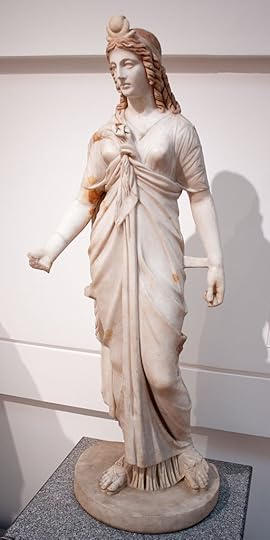 Roman-period Isis
Roman-period IsisScholars have long suggested that the Greek “romances” owed at least some debt to Egyptian sources. And yes, these books are romance novels in the classic sense: lovers fall in love, are parted by circumstances, adventure ensues, lovers are finally reunited.
Scholars such as the Classics professor Reinhold Merkelbach suggested that all ancient Greek novels (there are only five complete ones extant, with references to about 20 more) were informed by myth—but most especially by the Isis-Osiris complex of myths. Interesting, no? At the time of the Aethiopika, the myths of Isis and Osiris certainly would have been the ones most well known to Hellenes. Merkelbach further suggested that such tales were meant for the initiates of the Greco-Roman Mysteries, who would have understood the deeper meaning behind all the hidden clues. This theory has not generally been accepted, however.
Yet, at the very least, we can easily see the overall structure of the classic romance novel in the story of Isis and Osiris: lovers are in love, are parted by murder, the adventure of picking up the pieces ensues, and lovers are finally reunited, though one of Them is transformed.
The story of the Aethiopika reached far beyond the borders and time of the ancient Hellenistic and Roman worlds. The tale was influential all the way into the 17th and 18th centuries. That’s why all the illustrations I found for this article do not look remotely ancient Greek, Egyptian, or Ethiopian.
The Aethiopika is the love story of Theagenes and Chariklea. We meet Chariklea at the very beginning of the tale as a gang of Egyptian thieves approaches the scene of a beached pirate ship, with its crew slain, while they were in the midst of a celebratory banquet. As the robbers approach to scavenge, they see the beautiful Chariklea among the living. In sorrow, she is looking at a handsome young man who is wounded and perhaps dying. They exchange words and she tells him that, should he die, she will kill herself with the knife she bears.
 Chariklea looks upon the wounded Theogenes
Chariklea looks upon the wounded TheogenesShe rises to go to him—and the brigands step back, afraid. They think she is a Goddess, either “Artemis or Isis, the divine patroness of Egypt.” Others think she may have caused the slaughter as a frenzied priestess. Finally, they gain the courage to approach. Chariklea sees them, but continues to tend to Theagenes. Then, more thieves arrive, chase off the first group, and capture Chariklea and Theagenes. The prisoners are taken to the house of Thyamis, the chief thief, and given another prisoner as Greek interpreter. The interpreter, Cnemon, begins to treat Theagenes’ wounds with a healing herb.
We learn that Chariklea believes that Apollo is punishing the two of them because she and Theagenes fell in love with each other during the Pythian Games at Delphi and ran away together (she had been promised to another man). Chariklea had been abandoned by her Ethiopian parents, but was raised by a priest of Apollo at Delphi, becoming a priestess of Artemis. The pair of lovers fled Delphi, assisted by Kalasiris, an Egyptian priest of Isis.
It’s complicated.
 Chariklea captured by brigands
Chariklea captured by brigandsAnyway, during the night, Thyamis has a dream. He dreams he is in Egyptian Memphis, his home town, and there visits a temple of Isis. The Goddess entrusts the care of Chariklea to him, but Her commands come as a riddle, which he decides to interpret as telling him that he should take her as a wife.
But now a group of warriors come to attack the thieves. Chariklea is taken to a cave, while Theagenes must fight with the thieves. During battle, Thyamis realizes the true meaning of Isis’ dream message: that he will lose the battle and lose Chariklea. Pissed off at Isis, he goes to Chariklea’s cave to kill her—since he can’t have her; you know how it is—but in the dark mistakenly kills another woman.
Theagenes and Cnemon escape the battle, but believe that Chariklea is dead. Thyamis is captured alive, for it turns out this group of warriors was sent by Thyamis’ younger brother, who had earlier stolen his rightful priesthood from him. But Theagenes and Cnemon find Chariklea alive. The group decides to go south, further into Egypt, to find Thyamis and seek revenge for his killing of the other woman, who Cnemon knew.
 Rhodopis
RhodopisWhen they get to Khemmis, they are reunited with Kalisiris, the priest of Isis who helped them escape Delphi. He had believed Theagenes and Chariklea were dead and is thrilled to find them alive. We learn that, as a pious priest, Kalisiris drinks only water and never neglects to pour libations to the Deities. He is also a vegetarian, eating only nuts and fruits. In the course of events, Kalisiris tells how he came to be in Delphi.
A Thracian woman named Rhodopis came to Egypt, settled in Memphis, and set up shop as a courtesan. She would visit the temple of Isis where Kalisiris was high priest, where she made abundant offerings to the Goddess, for her business was thriving. Though Kalisiris practiced all types of priestly austerities, he could not resist Rhodopis’ charms and he fell hard for her (apparently after merely seeing her). His answer to escaping Rhodopis’ fatal allure was to leave his priesthood and his native Egypt to wander.
We further learn that Kalisiris is skilled in divination and had divined that his two sons were destined to battle each other. (Can you guess yet who Kalisiris’ sons might be?) Having heard of Delphi as a refuge for wise men, Kalisiris traveled there, arriving just at the time that the Pythia was prophesying. He received an oracle from the God telling him to take heart for he will be able to return to Egypt, but in the meantime to be the friend of Apollo.
 Chariklea awarding the prize to Theagenes at the Delphic Games
Chariklea awarding the prize to Theagenes at the Delphic GamesThe status of “friend of Apollo” greatly enhanced Kalisiris’ reputation and he joined a group of philosophers who peppered him with questions about Egypt and its Deities. Through Chariklea’s foster-father, Kalisiris meets her and witnesses as she and Theagenes fall in love instantly. And so, he is determined to help them.
So now our lovers, their companion, and Kalisiris are back in Egypt. There, they are involved in a number of adventures in which one or the other of the lovers gets entangled with other characters. A Persian governor’s wife falls for Theagenes, so she makes showy offerings at the temple of Isis, all the while lusting for Theagenes. At the same time, Kalisiris is devoutly praying before Isis about his sons and his own future. Previously, he had been reunited with his elder son, Thyamis the former chief thief, and even better, the two warring brothers were reconciled. Kalisiris declares that the eldest son, Thyamis, should inherit his Isiac priesthood for Kalisiris’ senses his own death approaching. The governor’s wife tries to frame Chariklea for poisoning, so she can have Theagenes. This, of course, fails. More adventures eventually find both Chariklea and Theagenes captured by the Ethiopian king—who is Chariklea’s real father, but who does not yet know her.
As sexual virgins, Chariklea and Theagenes are perfect sacrifices and are about to be sacrificed to the Sun and Moon, Deities of the Ethiopians. But wait! Due to a necklace that Chariklea’s mother had placed about her neck when she abandoned Chariklea, the Ethiopian king finally recognizes his true daughter. All is well. Chariklea and Theagenes are married and live happily ever after.
To be honest, the Aethiopika is a bit of a tedious tale. Yet, the reason I was reading this story was for the Isis lore.
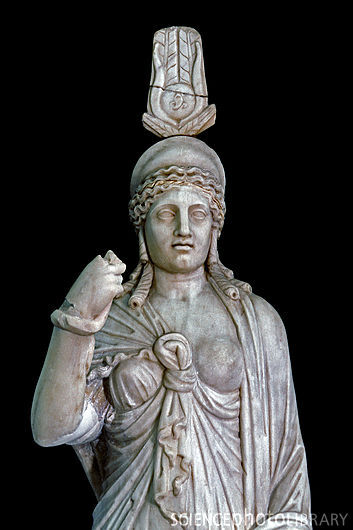 Hellenistic Isis
Hellenistic IsisFor example, we’ve learned about the pure-water-and-vegetarian diet of Kalisiris, a high priest of the Goddess. We know he is always pouring libations for the Goddess and any other Deities he encounters. We find that he is subject to visions and is a good diviner. We know that he must keep himself chaste—and so removes himself from Rhodopis’ disturbing presence.
From Thyamis’ dream, we see that Isis can send dreams, even in Loxian riddles, that can be misinterpreted by the dreamer. From the story of the Persian governor’s wife, we learn that not all rich offerings are sincere. In another part of the tale, we discover that offerings might be made to Isis if one has a bad dream. In yet another, the text tells us that initiates of the Mysteries call Isis the Earth and Osiris the Nile (but our speaker would reveal nothing more of those Mysteries). Oh, and we also learned that the love story of Isis and Osiris may well be the prototype for ancient Greek romances, and thus the roots of our modern romance novels, too.
Our Goddess can for found everywhere—for Isis is all things, and all things are Isis.
December 1, 2024
The Seshed Band of Isis
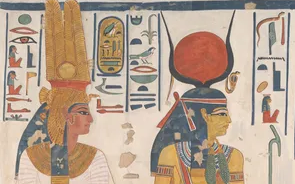 Isis leading Nefertari into the afterlife
Isis leading Nefertari into the afterlifeI have a new Isis accoutrement for you.
I love it when I find out new things—or new things about an old thing. This one is sort of an expansion on a previous thing.
Many of you may already be familiar with what are known as “black Isis bands,” which are needed in a number of rites in the Greco-Egyptian Magical Papyri (aka Papyri Graecae Magicae or PGM).
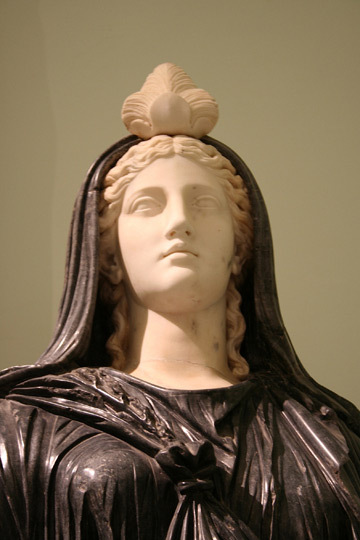 Roman Isis in Her black robes
Roman Isis in Her black robesWe can’t be sure, but I’ve theorized that these were made from the black cloth that had previously been used to clothe the sacred images of Isis, once the older robes had been replaced. Since the fabric was black, it would have been from Hellenized images of the Goddess. Egyptians did use cloth, both as offerings and to adorn their sacred images, but black cloth was not among the colors they generally favored.
What I’d like to share with you today is a different type of Isis band, an entirely Egyptian one. This band was given to Isis as an offering (see Offering to Isis, “Black Isis Bands”), and it was also worn by Her as part of one of Her various crowns. The information I’m working from is a dissertation by Barbara Ann Richter on The Theology of Hathor of Dendera. At Dendera, Isis is almost as prominent as Hathor. (And you’ll recall that Isis’ sanctuary at Philae also has a Temple of Hathor. Sisters!)
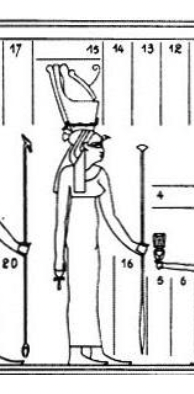 Isis from Dendera with Double Crown and seshed (the black squiggle at the base of the crown)
Isis from Dendera with Double Crown and seshed (the black squiggle at the base of the crown)On the walls at Dendera, we see scenes with Isis wearing this particular crown, which consists of the Egyptian red and white Double Crown, one or two ostrich feathers, and the “seshed” band, which is wrapped around the base of the red crown—or sometimes around the headdress of Isis.
We even have a 3D image of what this crown with its seshed band may have been like. Near the sacred lake at the Dendera temple, archeologists found a cache of ritual items including a cult statue of Isis with the double crown and seshed band—except in this case, the seshed is around the Goddess’ wig rather than around the base of the crown. (Although, in this picture, it looks to me like there is something—possibly multiple serpents?—around the base of the crown.) There are also two holes in the white crown, which Richter suggests may have been meant to hold real (or separate) ostrich feathers.
 Isis with the Double Crown and seshed band with serpent, holes possibly held real or separate ostrich feathers
Isis with the Double Crown and seshed band with serpent, holes possibly held real or separate ostrich feathersThe crowns and headdresses that the Egyptians represented the Deities wearing have specific meanings. The Double Crown represents rulership over the Two Lands, that is, Lower and Upper Egypt. The ostrich feather is the shut, the symbol of Ma’et—that which is Right, True, and Just. The seshed band is entwined by a uraeus serpent that is both protective and unifying, like the Double Crown.
In the Temple of Birth at Dendera (which I think is the Temple of the Birth of Isis), the king presents this crown to Isis and says, “Take for Yourself the seshed band. It has encircled Your forehead. The uraeus is united with Your head. The red crown and the white crown—they join together on Your forehead, the two feathers united beside them.” This crown emphasizes the unification of the land of Egypt as well as the powerful protection of the uraeus serpent. Since the crown is united with the Goddess, She embodies these qualities. And, of course, the Goddess bestows these same powers on the king in return, so we find the king wearing the seshed band at times, too.
 A picture of the whole statue of Isis with crown and seshed
A picture of the whole statue of Isis with crown and seshedThe feathers “united beside them” allude to Isis’ description as “Lady of Ma’et, the uraeus on Her forehead, appearing with Ma’et every day.” In this inscription, however, the word translated as “uraeus” isn’t “uraeus.” It’s Mehenet, which is the feminine version of the protective serpent Mehen, meaning “the Coiled One.” Mehen protects the God Re by encircling Him as He travels through the underworld; He also protects Osiris. Since Isis is a Goddess, She is united with the feminine serpent Mehenet. As a fiery Uraeus Goddess Herself, Isis protects Re and She is also the foremost protectress of Her husband Osiris as well as Her son Horus (and thus, the king). Mehen and Mehenet are sometimes shown with Their tails in Their mouths, making Them the prototype of the ‘serpent biting its own tail’ and later known as the oroboros.
In some of the Coffin Texts spells, Mehen is closely connected to Re. Coffin Text 760 tells us that after Isis brings Mehen, the Coiled One, to Her son Horus, Horus becomes “the double of the Lord of All,” that is, the Sun God Re. The serpents Mehen and Mehenet are solar powers and Their coiling and encircling protects.
 Osiris protected by the Coiled One biting His tail
Osiris protected by the Coiled One biting His tailThere was a tradition at Dendera that Dendera is the birthplace of Isis. An inscription in the sanctuary there says that Isis’ “mother bore Her on earth in Iatdi [that is, the Temple of the Birth of Isis at Dendera; also another name for Dendera as a whole] the day of the night of the infant in His nest.* She is the Unique Uraeus . . . Sothis in the Sky, [female] Ruler of the Stars, Who Decrees Words in the Circuit of the Sun Disk.” Since Isis is also Sopdet/Sothis/Sirius, the heliacal rising of the Goddess in Her star, just before sunrise, is Her “birth.” Her birth precedes the rebirth of the falcon Re—”the infant in His nest”—as He rises in the sun on the first day of the New Year.
 Sirius, the star of Isis
Sirius, the star of IsisThe birth of Isis is also connected with the seshed band. We learn that the “Ritual of Presenting the Seshed Band” takes place on “the Day of the Night of the Child in His Nest.” These seshed bands, presented to Isis for a happy New Year, included inscriptions like “A beautiful year—a million and a hundred-thousand times” and “A happy year, year of joy, year of health, eternal year, infinite year.” In addition to offering the seshed band on Isis’ birthday, it was also given on the first day of the New Year.
The seshed band must have been—at least originally—a fabric band, for it was tied around the head and knotted with the two long ends of the band hanging down in back. The knot at the back was surely intended to be magical, emphasizing the ability of magical knots to secure and protect, while the band itself surrounds and protects like Mehenet.
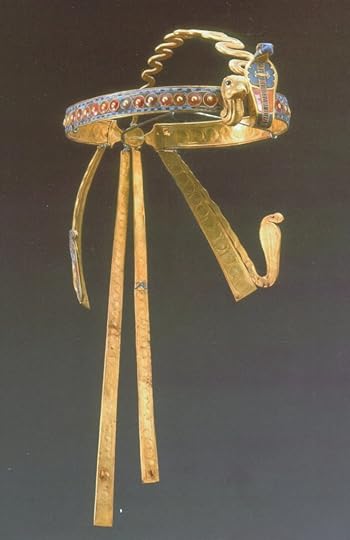 I don’t know whether this is actually a seshed, but the metal headband with streamers down the back looks like it may have been intended to mimic knotted fabric. This was on the head of Tutankhamun’s mummy.
I don’t know whether this is actually a seshed, but the metal headband with streamers down the back looks like it may have been intended to mimic knotted fabric. This was on the head of Tutankhamun’s mummy.The Pyramid Texts mention a powerful red headband with which the deceased identifies. Another Pyramid Text mentions a red and green headband that was woven from the Eye of Horus. While some Egyptologists connect these headbands with the seshed, I can’t be sure because I’m only looking at the English translation of the texts.
However, from Dendera, we do have an inscription that specifically describes a seshed band made of electrum. It is also possible that the fabric headbands had metal pieces, suitable for engraving with blessings, attached to them. It seems likely that the serpent that entwined the seshed would have been made of metal.
Egyptian Egyptologist Zeinab El-Kordy suggests that the word seshed is the active participle of shed, meaning “to draw or pull out” or “to cause to come.” He therefore connects it with drawing the Inundation out from its source and causing the flood to come. This could mean that the seshed band, especially when offered at the birth of Isis and the New Year, is a magical tool for helping to bring the much-desired Nile flood.
The seshed band protects and unifies. It is given as a talisman for New Year’s prosperity—which I think we can easily extend to good luck and blessings in general. And it is associated with rebirth and renewal. We also have scenes that connect it with birth as well as rebirth. They show the birthing mother, her midwives, and protective Birth Goddesses like Isis, Taweret, and Hathor, all wearing seshed bands.
 Egyptian woman giving birth assisted by Hathoru; crowns, but no seshed bands
Egyptian woman giving birth assisted by Hathoru; crowns, but no seshed bandsGiven this, I would suggest that if we are working with Isis in any of these areas—protection, unification, birth, rebirth, renewal, and even good fortune and good outcomes in general—we would be eligible to wear the seshed as part of our ritual gear. Although a custom-made uraeus serpent is probably out of reach for most of us, a fabric band in red (power and protection) or green (growth, change, benevolence) with a piece of inexpensive serpent jewelry attached to it, would be a perfectly serviceable seshed band for our work with Isis.
* Sources such as the Cairo Calendar connect the Night of the Child in His Nest with the 5th epagomenal day and the birth of Nephthys, while Isis’ birth is on the 4th epagomenal day. But at Dendera, Isis must have been considered to have been born on the 5th and last epagomenal day, rising as Sothis just before the sun. When the sun rises, the 5th epagomenal day officially ends and the new day and New Year begins. As is so often the case with Egypt, the myths and traditions could vary from place to place.
November 24, 2024
Offering to Isis Now Available for Pre-Order
Dear friends and fellow Isians,
I’m very—very!—excited to let you know that Offering to Isis, Knowing the Goddess through Her Sacred Symbols is available for pre-order from Azoth Press at the Miskatonic Books website right now. If you’d like to go directly there, here’s the link.

I know a lot of you are familiar with Isis Magic, but maybe you haven’t yet come across Offering to Isis. I may be a tad bit partial, but I really like this book a lot, too.
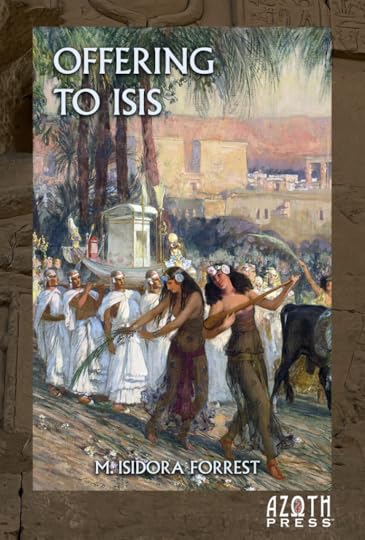
Offering to Isis is about how we can connect with, honor, and grow our relationship with Isis through the ancient and eternal practice of making offering. Offering is one of the most important ways we human beings have always communicated with our Deities. It was vitally important in ancient Egypt and it’s just as important for those of us interested in or devoted to Isis today.
If you’ve ever wondered exactly what sort of things to offer to Isis, Offering to Isis includes in-depth explanations of 72 sacred symbols associated with Isis—symbols that make ideal offerings to Her.
We’ll also talk about the how and why of Egyptian offering practices, including the important and genuinely ancient Egyptian technique of “Invocation Offering.” There’s information on exactly how the ka energy inherent in every offering is given to and received by Isis—and what to do with offerings once they’ve been received. You’ll also find a selection of offering rituals, from simple to complex, for a variety of purposes. Most rites are for solitary devotees, so I think you’ll find one that works just right for you.
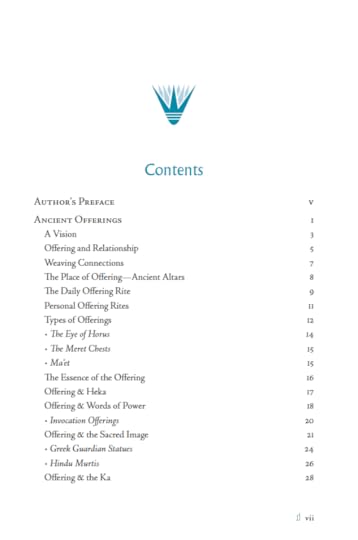 You can download a complete copy of the Table of Contents by clicking here.
You can download a complete copy of the Table of Contents by clicking here.If you’re curious and want to know exactly what’s in the book, you can download a PDF copy of the full Table of Contents by clicking on the caption under the “Contents” image.
The largest section of the book details the 72 sacred symbols of Isis. You’ll add to your knowledge of Isis and Her ancient worship by learning more about Her through Her important sacred symbols. You’ll see how each one is intimately connected with Her and how they may be used in offering rites for Her. Every entry also includes an Invocation Offering that you can use for your own offerings to Isis.
One of the things I especially like about this book is that you can just open it at random and you’ll likely find something you hadn’t known about Her, something that I hope will inspire you in your own devotions. For instance, how did the Knot of Isis come to be Her knot? What stones are associated with Her? What animals are connected with Her? Why are dreams especially important when it comes to Isis?
As it’s been a few years since this book was first published, the text has been thoroughly updated. All the hieroglyphs associated with the offerings have been re-illustrated and are much more accurate—and much more beautiful, if I may say so—in this new edition, too. There’s also a handy appendix in the back for quick reference in finding any offering you may need.
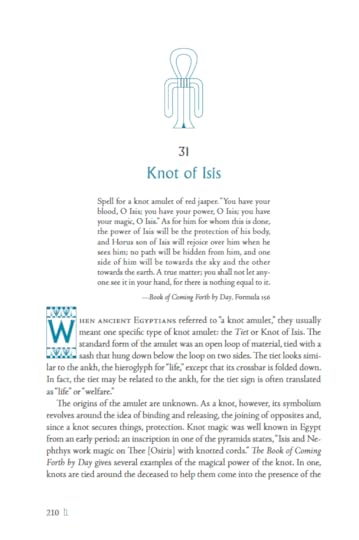 This is what a typical page in the sacred symbols section looks like.
This is what a typical page in the sacred symbols section looks like.This new Azoth Press edition can be purchased only through the Miskatonic Books website. (If you go to Amazon, you will be ordering a 20-year-old paperback edition published by Llewellyn in 2005, which people are trying to sell at very inflated prices.) Oh yes, and if you’d like, you can take advantage of Miskatonic’s installment plan that lets you pay over several months so it doesn’t take a big bite out of your budget. Plus, the new hardback edition is priced A LOT lower than those overpriced, out-of-print first editions that I’ve seen out there.
When you go to the Miskatonic site, you’ll see two different Azoth Press Offering to Isis editions. For the high rollers, there will be 36 copies in a gorgeous leather-bound and numbered collector’s edition. For the rest of us, there will be 650 numbered, limited edition copies in a cloth-bound hardcover. Both editions are two-color throughout, and more than 400 pages.
Thank you so much for letting me tell you about this new edition. And would you please do me a favor and share this information with anyone who you think might be interested? And please feel free to ask me any questions about Offering to Isis that you’d like.
I’m looking forward to getting my own copy of this beautiful, new edition of Offering to Isis. And while you might think it’s strange, even though I wrote the book, I still use it for reference when I’m making offering to Isis. I hope this new edition will serve you well, too.
Under Her Wings,
Isidora
November 17, 2024
Awakening Isis
As the teal-blue waters of the Nile swirl and eddy upon the rocky shores of Her island; as the daily rebirth of Re fills the horizon with colors of peach and purple and red; as Mother Night smiles at the glory of Her reborn child—every morning, in Her beautiful temple at Philae, the Great Goddess Isis was awakened in Her sacred image.

This morning, She was awakened in Her smaller temple, the shrine I have made for Her in my home, and the lamp I have set for Her in my heart.
My ritual is not the ritual in the ancient temples. But the intent is the same: to call in, renew, and reawaken Her ka, Her ba, and Her akh—at least the sparks of each that reside within Her sacred image on my altar—so that She may be present with me and I may be present with Her. I honor Her, awaken Her in peace, and place before Her the Offering of the Morning.
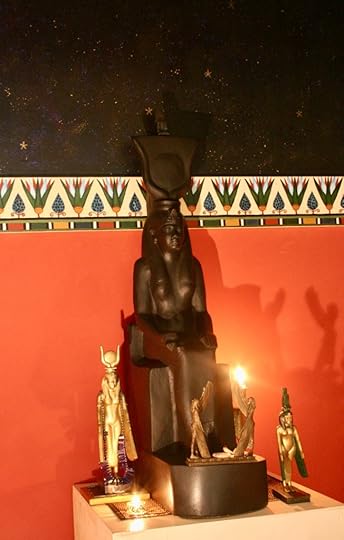
As I enter Her shrine, my hands crossed upon my breast, I bow to Her veiled image. I light the charcoal, prepare the incense, a special blend made for Her by artisans of sacred scent. I pour pure Nile water into the libation cup and ready the libation bowl.
And then I sing to Her. “Isis is the wisdom that is given in the Boat of the Morning. Isis is the wisdom that is given in the Boat of the Night. Isis is the wisdom that is given in the Boat of the Morning. Isis is the wisdom that is given in the Boat of the Night. Isis, Isis, Isis.” I continue to sing until the chant seems complete.
Now, I make the gesture of Opening the Shrine, flinging wide for Her the doors of Her shrine. I vibrate Her name, “Isis!” I unveil Her beautiful image and look upon it.
I kneel before Her, then sit.
I open my awareness. As I breathe deeply, the lamp in my heart grows brighter.
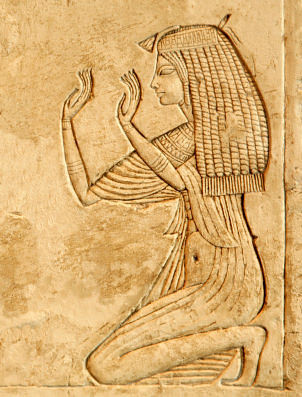
I open my awareness. I sense the ka of the Goddess’ living power like a bright tingle on the nape of my neck.
I open my awareness. I turn my face upward and envision Her ba—in the form of Her sacred raptor, the black kite—swoop down from above, fast and sure. It alights upon Her sacred image and nestles softly into Her lap. All the while, I am chanting Her name in my mind, in my heart, in my mouth.
I open my awareness again. Her spirit, Her akh is coming. It is like the welcome light of dawn after a long, dark night. It is like water to those who thirst. It is like a needed, deep breath that makes my chest shudder as I take it in.
I say aloud to Her: “A spark from Your Mysterious Heart, Isis, resides within this sacred image. I honor that spark as I honor You Yourself, Great Goddess.”
Quietly, and with my awareness opened to the ends of the earth, I vibrate Her name three more times. I feel Her ka. I see Her ba. I sense Her akh.
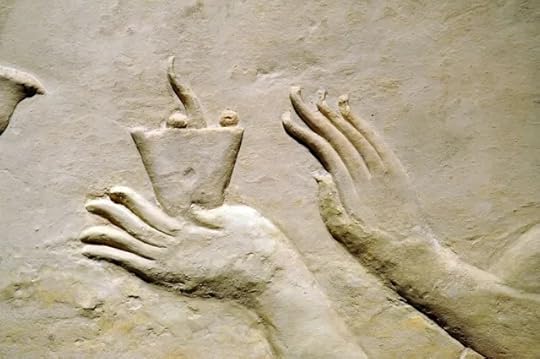
And I say aloud to Her, “Awaken, O Isis Within, to this beautiful day. Be welcomed into morning! Awaken, O Isis Within, to the joy of the day. Be welcomed into today!”
I take up the incense and place it upon the charcoal. The resins and herbs and flowers burn, releasing their scent. Taking up the censer, I elevate it toward Her image. “May Your eyes be opened to the beauty of the day,” I say. “May Your nostrils be opened to the sweet scent of this spice. May Your ears be opened always to the voices of Your children.”

I replace the censer and take up the libation cup of pure Nile water. I elevate it toward Her image, then pour it, very slowly, into the waiting libation bowl. “May Your lips be opened to the sweetness of this cool water,” I say. “May Your heart be opened to Your people this day. May Your body, O image of Isis, be opened to the beautiful energy of Isis the Goddess, Ever-Living.”
I am seated once more. I become aware of my heart. I breathe and let the lamp burn brighter. And brighter. I am aware of the sacred image of Isis before me. I feel Her presence. I sense Her heart. I breathe my fire into Her heart. She returns it to mine. I know Her image breathes. I breath Her breath. I am illumined in Her dawning fire. I speak Her words for Her: “I am that Golden morning that arises and shines each day. Splendid are the ornaments upon My brilliant brow. I am the One Who glows in the Sun. I am the Eye of Awakening. I am the Greening of the Earth. I am the Joy of the Day.”
I let myself sit in Her Presence for a while, enfolded in Her wings. When I am ready, I stand and say to Her, “Awaken in joy, Isis, awaken in joy. Amma, Iset.”

November 10, 2024
Isis on the First Day
Do you remember the first time Isis made Herself—really important—in your life?
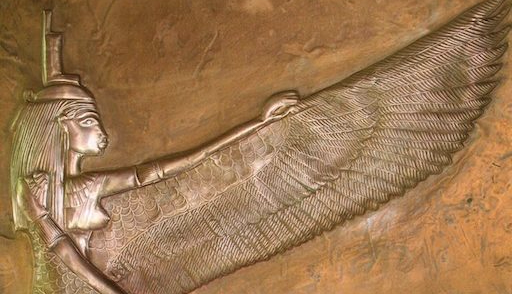 Copper repousée Winged Isis by Raya
Copper repousée Winged Isis by RayaFor me, it’s been a long time. In fact, I can tell you that I have been Her devotee for most of my life now. And I have been Her dedicated priestess for decades.
Of course, even before any formal declarations, I’d been dancing with Her for a while. I would often find myself reading about Her, looking at images of Her, wondering about Her.
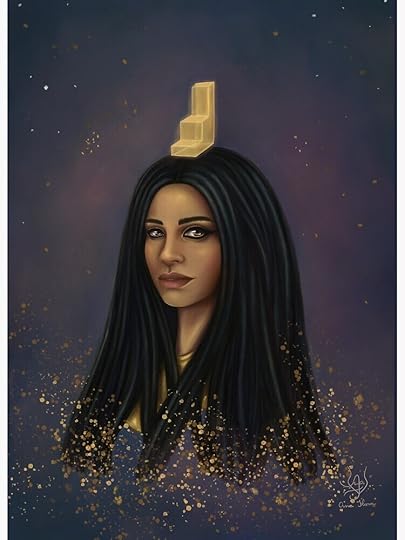 Purchase your copy of this art here.
Purchase your copy of this art here.And the crazy thing was that, at the time, I was actually looking for a Divine relationship; I was looking for my Goddess. But in my youthful rebelliousness, I thought a more obscure Goddess would be more appropriate for the uniqueness—okay, weirdness—that is me. Isis, I thought, was way too ordinary; everybody knows Isis. At least Her more mysterious Dark Sister Nephthys should be my Goddess. I must have closed the door in Isis’ face half a dozen different times. You’re cringing; so am I.
But Isis is a Goddess and I am only a thick-skulled human. My lack of commitment did not put Her off at all. She simply kept coming back and tapping on my shoulder (this is Her way; please see Isis the Ass-Kicker for more on that).
Alas, the story I’m telling now has no riveting suspense. Eventually, She just wore me down and I began preparing to dedicate myself to Her.
I did my research. I wrote my ritual. I made my purifications and prayers. On the appointed day, I began the rite. But about halfway through, I began to feel very faint. VERY faint. (You see, in those long ago days, this often happened to me in the presence of magical energy; I’d go very pale and start to pass out. Many is the time when my fellow ritualists had to stop mid-rite and prop me up for a while.)
 Isis of Coptos, now in the Turin Egyptian Museum
Isis of Coptos, now in the Turin Egyptian MuseumNonetheless, I was determined to finish the ritual and did so while sitting on the floor in front of the altar. Part of the rite involved formally asking the Goddess to accept me as Her priestess. The short answer I got was, “No.” But the longer answer was, “Go study and come back in a year.”
So, that’s exactly what I did. A year later, I reworked the same ritual, didn’t faint, and was accepted. Not long after that, I got a strange and wonderful confirmation of Her acceptance, too. A woman I barely knew came to me on a mission from the Goddess. I think she was as confused by it as I was. She’d had a dream of Isis that was so strong that she simply had to act on it. In the dream, Isis told her to come to me and give me a gift of earrings in the form of a Winged Isis. She did—and I knew that Isis had truly claimed me.
The path of devotion to Isis isn’t always what we expect. In fact, I don’t think it should always be what we expect. When things take an odd turn, I usually consider it a sign that I’m in contact with true Divine energy. If things go exactly as I thought they would, it can mean that I’m merely fulfilling my own expectations. While that’s not always true, it is indeed something to be aware of—a warning that we may be talking to ourselves rather than talking to Isis.
 Isis’ name in hieroglyphs, from Abydos
Isis’ name in hieroglyphs, from AbydosIt is good to remember how it was on that First Day. To remember the circumstances again. To feel the feelings again. As you likely know, the idea of the First Day was extremely important to the ancient Egyptians. The renewal and re-creation of the First Day, the First Time, the First Occasion, the Zep Tepi in Egyptian, was the magic they were continually Working. Every temple was the place of the First Day, every day. Every ritual reenacted the First Day, every time.
I don’t know about you, but I am feeling the need for the renewal of that First Day right now. And so, I will do as the ancients did. I will tend the shrine. I will work the rituals. I will make offering. I will go back to the beginning and do the rites and meditations I did when I was first coming to know Her—the ones you will find in Isis Magic and Offering to Isis. I know they will different for me this time. And yet, I know they will still take me back to that First Day. And I will hope to be, like Osiris, renewed and reborn under the Wings of Isis. Amma, Iset. Grant that it be so.
November 6, 2024
Beautiful Mourner, Weep with Me
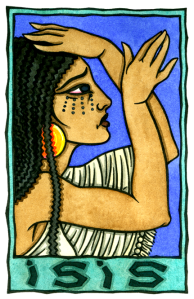 Thalia Took’s beautiful image of Isis mourning. You can get prints of this work here.
Thalia Took’s beautiful image of Isis mourning. You can get prints of this work here.We need to know that we are not alone in our pain and outrage. And we are not.
For right now, our Goddess hears us. She knows our hearts. She, too, has mourned. She, too, has raged. She, too, has feared. She understands us when we bring our hollow hearts and roiling bellies to Her.
She will hear us, hold us, advise us. In time, She may even heal us.
But before that healing, we must feel what we feel. The God has died and He must be mourned.
We can share the burden of our feelings with others who mourn with us. We can share them with our Deities, with Her.
Yet at some point, the mourning time will pass. And what will we do then?
If we would follow Her, then what we must do is rear the fatherless Child. We must continue taking action. We must continue our Work.
Though we see the enormity of the problems, let us not despair; there is hope; there is opportunity. Instead, let us renew our dedication to our Deities and our spiritual work, for this will strengthen our souls. Let us renew our support of progressive institutions with our dollars. And let us continue to work with others in progressive organizations for the changes we want to see.
Our Goddess is strong and practical; let us follow Her in this wisdom.
But if—right now, at this time—you mourn, it is well. Make an offering to Isis of your mourning. She will receive it from you…
This is a gift I bring before the Beautiful Mourner, Isis the Weeper Who Transforms: an invocation offering of mourning.
I offer You, Isis, my mourning for there is nothing else I can do with it. How is it that something so empty can be called pain-full? I am abandoned in an ocean of pain so deep that there is nothing else. My tears are nothing but more salt for that bitter sea. My grief is nothing but a hole in my belly. I cannot breathe. I have no breath. There is no air. My mind is blank, unable to receive the words that are pushed at me. My heart? I have no heart.
Mourning is what we do when the loss is so great that we can do nothing else. Each of us who mourns has her or his own share of this hollow pain. But it is the pain of one human being at one time, in one place. You, Isis, You hear the cries of the world. You feel each heart breaking, You know every human cruelty.
The sorrows of a Goddess are deep. What then is my mourning compared to Yours?
Listen, O Isis, to the words of Mourning: “I am offered unto Isis for She is the Well of Mourning. She absorbs me and takes me into Her vastness. I am dissolved in infinity. I am mixed with all things. I am reborn as a child. I am the mystery of suffering. I am Mourning.”
Unto You, Isis, I offer my mourning and all things beautiful and pure. M’den, Iset. Accept it, Isis.




